

Sonic's Short History
 Sega's Sonic the Hedgehog didn't go through as many evolutionary stages as Nintendo's Mario. Fewer Sonic games were released than Mario games, over a shorter timespan, and they were - at least in the 2D era - confined to two consoles. Sega's MegaDrive (Genesis) was where the blue rodent got his start, but in a move unusual in the games industry almost all of the Sonic games were ported backwards to Sega's Master System console, a generation of hardware older than the MegaDrive. This move is not surprising when you consider Sega's massive following in Brazil, Europe and Australia where, even as late as 2003, the Master System was seeing new releases.
Sega's Sonic the Hedgehog didn't go through as many evolutionary stages as Nintendo's Mario. Fewer Sonic games were released than Mario games, over a shorter timespan, and they were - at least in the 2D era - confined to two consoles. Sega's MegaDrive (Genesis) was where the blue rodent got his start, but in a move unusual in the games industry almost all of the Sonic games were ported backwards to Sega's Master System console, a generation of hardware older than the MegaDrive. This move is not surprising when you consider Sega's massive following in Brazil, Europe and Australia where, even as late as 2003, the Master System was seeing new releases.
(note: this article is a rewrite of a segment that appeared in my book)
The Sonic Basics: MegaDrive
There were only five Sonic games on the MegaDrive, ignoring games that re-used sprites (Sonic & Knuckles, Knuckles' Chaotix & Sonic CD). The Sonic sprites below show a clear progression, and it's easy to see how Sega's artists refined their mascot's image. Sonic was initially a less vivid shade of blue, something that changed in Sonic 2 to help Sonic stand out against the background, and stayed that way for the rest of the series.
There was a steady progression in Sonic's limbs. The first Sonic had very skinny arms and legs, but by Sonic 3 they were quite a bit more muscular in appearance. Sonic's shoes, perversely, seemed to get cleaner as time went on - by the third game they were gleaming, and they seemed to be much rounder. If you look carefully you can see how Sonic's running skills have straightened out his feet too. The feet on the first generation Sonic tended to orient the soles inward. Hedgehogs are known for their unusual gait, but this might have been too unusual for Sega: Sonic's feet were snapped into place fron the second game onwards.

Left to Right: Sonic 1, 2, 3 and Sonic Spinball - MD/Gen
The standing position saw fewer changes than the running one, at least between the first and second games. Except for some widening of the eyes in Sonic 2, giving Sonic a less angry appearance, the sprites are identical. The adjustment from the second to third games is much more extreme. Sonic was given much larger hands, and because of their placement Sonic almost looks chubby. Previous iterations had him thrusting his chest forward with his arms back, but now he appears more relaxed. His cheeks appear rounder, and there's now the suggestion of a mouth, where there never was before.
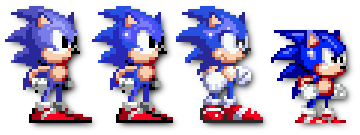
Left to Right: Sonic 1, 2, 3 and Sonic Spinball - MD/Gen
The Master System and GameGear
It is unusual for a manufacturer to support two different generations of hardware at the same time, and if it
does happen, it doesn't happen for long. Sega was unique in their ability to maintain continued success with two generations of hardware at the same time.
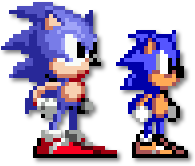
Sonic 1 - MD (Left), Sonic 1 - SMS (Right)
The first two Sonics were identical except for the colour of Sonic's shoes. Significant changes were made to the third Sonic, making him cuter and rounder, like the MegaDrive Sonic 3 sprite. Sega was also unusual in their ability to cross genres with their mascot. Normally a flagship product isn't changed very much to avoid alienating fans, but when players raved about the pinball levels in the original Sonic games Sega listened. Sonic Spinball was the result, a kind of adventure pinball where Sonic spent most of the game rolled up into a ball bouncing around a giant pinball machine. Pinballs aren't very big, and Sonic was necessarily reduced in size again.

Left to Right: Sonic 1, Sonic 2, Sonic Triple Trouble, Sonic Chaos, Sonic Labyrinth, Sonic Spinball - SMS
The GameGear, with its lower price point and library of short 'throwaway' games received several updates that the MegaDrive didn't. Sega, it seemed, was more willing to experiment on the GameGear since the audience was smaller, the costs were lower and the risks - of flooding the market or diluting the value of their mascot - were reduced. These games included new levels and game types as well as several additional revisions of the Sonic sprite. While the hardware wasn't capable of displaying the large, detailed sprites seen on the MegaDrive Sega's artists still managed to achieve some very acceptable results.
The GameBoy Advance
After Sega's mismanagement saw their fortunes seriously flagging, they began releasing games on platforms other than their own. The last 2D Sonic to see release was on Nintendo's GameBoy Advance, and for this Sega saw fit to do a complete overhaul of their venerable
erinaceus. This new Sonic was all very significant departure from the old designs.
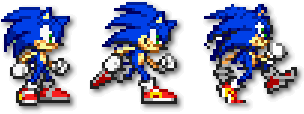
Sonic Advance - GBA
Despite using the same number of colours as the MegaDrive Sonic, the smaller GameBoy Advance screen meant that the new sprite was not even as tall as the Master System/GameGear one, and suffered a bit for it. Sonic was a bit sketchy, without the clearly defined shape and charm of old. None of the GameBoy releases really captured the magic, the new games seemed remade for a generation that no longer cared. Despite animating the new Sonic much more smoothly, with many more animation frames, they took shortcuts that resulted in a very ugly sprite. When running up hills Sega opted not to draw new sprites, but instead the GBA rotates the existing sprite, and it looks dreadful. On the other hand, before the GBA Sonic didn't look any different whether he was running uphill, downhill or on a flat: the sprite used was the same for all three.
The Aberration
A little-known arcade release of Sonic saw a radical departure from Sega's normal technique. Presented in an isometric 3D style, using trackballs for control, the arcade game was very much a cross between Sonic and Atari's Marble Madness. Sonic had a very round style, as he was a rolling blue spiky marble as often as not. Interestingly this sprite was designed after the MegaDrive's Sonic 2 and before Sonic 3. Despite being the best-looking Sonic game it never received a home port. It's probably for the best, without the trackball controls it wouldn't have been any fun at all.

SegaSonic - Arcade
The Ugly Years
Before Sega went totally 3D with their awful Sonic R and Sonic Adventure games, they tried the pre-rendered route. Nintendo didn't do it first, but they were first to do it right with Donkey Kong Country. Sega didn't really know what the hell they were doing, and their pre-rendered games were, at best, bad. They were not fun to play, and once the novelty of the graphics wore off they were usually put back on the shelf forever. The graphics are terrible: Sonic did not translate well to low-res low-colour isometric sprites on the MegaDrive (also Saturn), and looked even worse on the 64-colour Master System. Despite the game's failure on the MegaDrive, Sega saw fit to release another pre-rendered game on the less capable Master System as well. Sonic Blast was ugly, and was not a success.

Sonic Blast - Master System (Left), Sonic 3D - MegaDrive (Right)
Seriously - what's gone wrong with his nose? You'd think game companies would realize that pre-rendered sprites are the devil's own work, but no. No, they keep on trying, and the result is always less than a what a proper, created-with-love sprite would be.
The Other Sonics
As Sega's star was fading, they farmed Sonic out to other companies in an attempt to get money wherever they could. SNK released Sonic Pocket for their doomed NeoGeo Pocket Color system. This new Sonic was much smaller than normal, but was redesigned from scratch to suit the smaller screen. Sadly the Sonic released on Tiger's even more doomed Game.com platform wasn't so lucky. Based on the MegaDrive Sonic 3 sprite, the Game.com version was large and indistinct 4-colour mosaic.
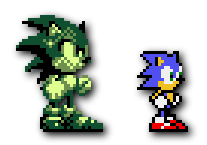
Sonic Jam - Game.com (Left), Sonic Pocket - NeoGeo Pocket Color (Right)
Console Porting
Porting games from one console to another is never an easy task. Even small changes to resolution can result in fierce difficulties making the graphics look right and the game play as well as the original. Sega had a very strong financial incentive to shoulder this burden, and so with Sonic they did exactly that. As you can see below, the changes were huge: the resolution was lower, the number of sprites available was
far lower, and there were fewer colours.
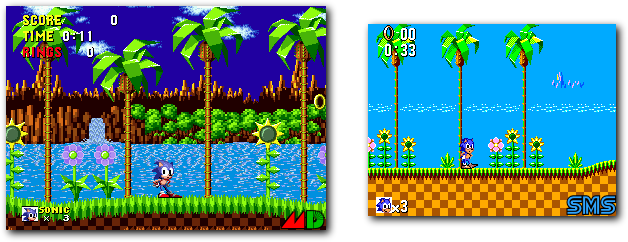
Sega didn't just have it easy when it came to back-porting their games to older hardware. In a particularly clever move they released the Game Gear - a portable system - based on the proven and familiar Master System hardware. It had a very small screen, with a lower resolution than even the Master System, but they also upped the quality of the graphics, from 64 colours to 4,096. It can be debated
ad nauseum whether there was a real benefit to so many colours on such a shitty screen, but the GameGear sold well enough.
Except for the physical size of the cartridges Master System games would run without modification on the GameGear, so Sega was able to provide games for several markets with each of these 8-bit games they produced. In addition, because of its success in Brazil and to a lesser extent Europe, the Master System saw releases of several Sonic games long after support for the system would normally have been discontinued, and in fact these games never saw release in North America, Sega's most successful region. By programming for the GameGear first Sega could supply their portable audience with new games, and then release these same games for the Master System in other countries.
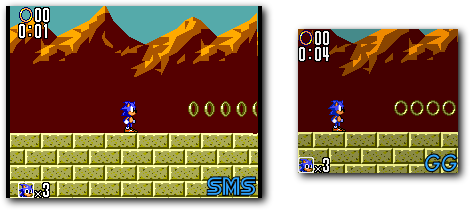
Despite the sizable market for these games, no amount of programming wizardry could make the aging 8-bit hardware accurately replicate games from the MegaDrive. Fewer colours and less powerful hardware demanded that sacrifices be made, none so evident as the reductions made to the Sonic sprite itself.
It wasn't always a perfect process. The CPU, taxed to the limit running the smaller GameGear games, was overloaded when it was asked to handle the higher resolution. Since the Master System had a much higher resolution than the GameGear games tended to run much slower on the Master System.

Summing Up
Creating the same character sprites on different platforms is a tough job at the best of times. Sega had their work cut out for them with their many releases over two primary platforms, and as you can see they usually nailed it. During the 16-bit heyday Sega employed some very talented people, and most of their efforts were as good as anyone could hope for.
Lawrence.
Many thanks to Christopher Coleman for a thousand nitpicking corrections and suggestions...
Addenda
Several people have raised interesting points about this article:
Sonic Spinball wasn't really a Sonic game. This is debatable - there were pinball levels in Sonic, and Sonic could run and stand (albeit briefly) in the Spinball game, so...
 I use the word 'port' rather liberally...
I use the word 'port' rather liberally... I do! Technically many of these games aren't ports, as the games themselves are very different (different levels, etc), but the graphics are similar enough to be considered ports. A person could argue it both ways.
What about the other GBA and DS Sonics? The other GBA Sonic games re-use the same sprites, and the DS one uses polygons instead.
And Sonic Battle? Sonic Battle is to Sonic as Mario Kart is to Mario: the same characters are in it, but the game is totally different.
 Sega's Sonic the Hedgehog didn't go through as many evolutionary stages as Nintendo's Mario. Fewer Sonic games were released than Mario games, over a shorter timespan, and they were - at least in the 2D era - confined to two consoles. Sega's MegaDrive (Genesis) was where the blue rodent got his start, but in a move unusual in the games industry almost all of the Sonic games were ported backwards to Sega's Master System console, a generation of hardware older than the MegaDrive. This move is not surprising when you consider Sega's massive following in Brazil, Europe and Australia where, even as late as 2003, the Master System was seeing new releases.
Sega's Sonic the Hedgehog didn't go through as many evolutionary stages as Nintendo's Mario. Fewer Sonic games were released than Mario games, over a shorter timespan, and they were - at least in the 2D era - confined to two consoles. Sega's MegaDrive (Genesis) was where the blue rodent got his start, but in a move unusual in the games industry almost all of the Sonic games were ported backwards to Sega's Master System console, a generation of hardware older than the MegaDrive. This move is not surprising when you consider Sega's massive following in Brazil, Europe and Australia where, even as late as 2003, the Master System was seeing new releases.













 I use the word 'port' rather liberally... I do! Technically many of these games aren't ports, as the games themselves are very different (different levels, etc), but the graphics are similar enough to be considered ports. A person could argue it both ways.
I use the word 'port' rather liberally... I do! Technically many of these games aren't ports, as the games themselves are very different (different levels, etc), but the graphics are similar enough to be considered ports. A person could argue it both ways.